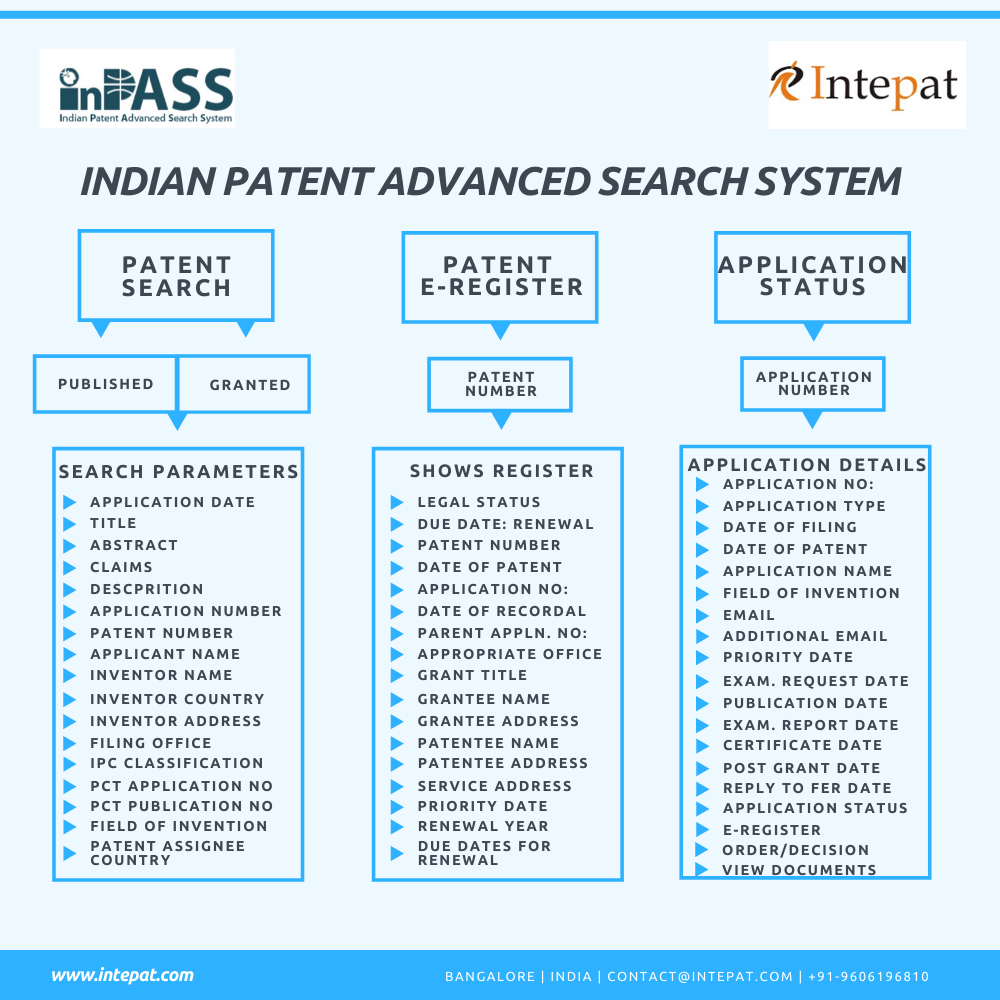Indian Patent Search System
The Indian Patent Advanced Search System [InPASS] is an updated version of IPAIRS as it allows for a full-text search of all Indian patents and Patent Applications. InPASS also enables a person to conduct a patent search using Wild Cards and Boolean Operators.
InPASS is the patent office database of IP India and is used to conduct an advanced patent search in India.
Conducting a patent search is indispensable before filing a patent application. Before discussing the Indian patent search system, let us understand the basics of patent search.
What is a Patent Search?
A patent search or patentability search is a search conducted in patent databases and the available literature to check whether any invention similar to your invention already exists. In other words, it evaluates your chances of getting a patent grant.
Therefore, instead of going forth with the filing, if one conducts a comprehensive search, one can get a clear idea about the patentability of the invention, specifically, the strengths and weaknesses of the invention. Based on the analysis, one will have to decide whether or not the application should be filed.
Why Conduct a Patent Search?
Filing a patent is an expensive process. The official patent fees (statutory fee) for a basic patent filing can be anywhere from INR.5,600 – INR.28,000. Besides the official fees, the fees of the patent attorney or agent also need to be considered. Imagine spending money on trying to get a patent, only to find out that your invention was never patentable! Thus, a comprehensive search avoids this situation.
Besides financial reasons, there are several other compelling reasons for conducting a search before filing a patent application in India or globally.
Reasons and benefits:
1. A patentability assessment can help you understand whether your invention is patentable. And if so, how far can it be protected? For example, computer programs, per se, are non-patentable, but computer programs that are manifested in a useful way can be patented.
2. A comprehensive patent search reveals the prior art in your field of invention. This will come in handy when drafting the patent specification. The knowledge of prior art will help you determine if your invention has any value addition over the prior arts. This will reduce the chances of rejection by the Patent Office.
3. If your invention has no value addition, then understanding the prior art will help you refine it to make it patentable.
4. The patent search can also reveal certain companies keen on obtaining patents in the technology field relating to your invention. In such cases, it gives you the lead on which companies to contact for licensing your invention.
5. Ordinarily, every Applicant wants his patent to become commercial and, therefore, a source of finances. A patent search reveals inventions similar to your invention and the commercial value of the invention in the economy. Based on this, you can determine the commercial value of your invention.
6. Another important reason for conducting a patent search is that the applicant needs to describe his entire invention while applying for a patent. Even if his patent gets rejected, his application would be considered prior art, open for all to see. This means that competitors can get free access to their hard work. A patent search helps avoid such a situation. Even if your invention is not patentable according to law, you can use it as a trade secret and gain revenue.
InPASS database
In this blog post, we provide a basic outline of how to use the Indian patent (advanced) search system to conduct patent searches, check the register details of patents granted, and check the patent application status.
At the outset, it is important to explain the layout of InPASS. The InPASS database provides four menu tabs: Patent Search, Patent E-register, Application Status, and Help.
In the ‘Patent Search’ tab, two check boxes are provided that allow you to search for Granted patents, Published applications, or both.
After choosing that, you can search for patents or applications published based on any of the following search parameters:
| 1. Application date- You can choose a range of dates | 2. Title |
| 3. Abstract | 4. Claims |
| 5. Description | 6. Application Number |
| 7. Patent Number [For Granted Patent] | 8. Applicant Name |
| 9. Inventor Name | 10. Inventor Country |
| 11. Inventor Address | 12. Filing Office |
| 13. International Patent Classification (IPC) | 14. PCT Application number
[for national phase application] |
| 15. PCT Publication number | 16. Field of Invention |
| 17. Patent Assignee Country |
Keyword Search:
First, you will have to collect the keywords relevant to your invention or patent. The keyword search can only be used in the search parameters – title, abstract, claims, and description. The patent search can be performed using the keywords along with ‘Boolean Operators’ and/or ‘Wild Cards.’
The search results will show in two columns. The application number/patent number, title, date, and status will be in the left column. Based on selecting a row in the left column, details [Bibliographic Data, Specification, and Status] of the patent application/granted patent will be displayed in the right column.
Further, in the respective tab, you can view the details of Bibliographic data, the patent specification, and application/patent status. However, there is a limitation to displaying the number of search records up to 1000 and 25 records per page.
Applicant Name Search:
The Indian patent search database allows you to search for patent applications/patents by entering the applicant’s name against the relevant row. All you have to do is enter the Applicant’s name and press search. The result will display the title of all inventions published or granted in the name that you entered.
Inventor Name Search:
Similar to the applicant name search, you can also search the inventor’s name in the relevant row and the result display.
In addition to the above searches, you can perform various search queries to retrieve the results based on your requirements. You may also read the ‘Help’ provided on the tab to learn more about how to use Boolean operators and Wild cards. If you are familiar with the USPTO patent search or WIPO patent search, you can easily conduct the patent search in India.
Patent E-register
The Indian patent search database allows you to check the legal status of the granted patent. In the ‘Patent E-register’ tab, enter the patent number and the displayed code and click to Show E-register. The result will display the legal status of the patent, the next renewal date, and the Bibliographic data of the patent.
Application Status
Similar to the patent grant search, the Indian patent search database allows you to check the patent application status. In the ‘Application Status’ tab, enter the application number along with the displayed code and click on ‘Show Application Status.’ The result will display the details of the application, such as application number, applicant number, date of filing, priority date, title of the invention, publication date, and also application status. Besides, you will be able to view all the documents relevant to the patent application in the ‘View Documents’ tab provided at the bottom page of the result.
Patent Journal
Indian patent office publishes the patent journal every week Friday, and we can view the details of the patent journal provided in the link.
Conclusion
Even though free patent search databases allow anybody to conduct a patent search, it is important that a person skilled in conducting searches be given the task. The reason is patent searches involve tedious, repeated searching through various patent and non-patent literature. An unskilled person would be unable to do justice to the vast amount of literature to be searched. Furthermore, a skilled person understands the importance of patent claims. The claims of a patent are of the utmost importance when a similar patent to your invention exists. In such a case, one needs to analyze the patent claims to determine the degree of similarity between the two.
Furthermore, a skilled person would be able to build on the strength of your patent or refine it so that it does not infringe on other existing art. A non-skilled person may not understand these concepts.
Professionals at Intepat understand the realms of patent searches, conduct comprehensive searches in patent and non-patent literature, and provide counseling on the management of patents.




